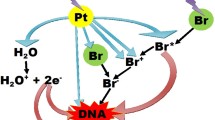Abstract
Six anilinoacridine derivatives have been tested for the ability to act as radiosensitizers. Two gave good sensitization at concentrations of 100 microM or less. Both of these are known to possess significant activity against experimental tumours, and one (m-AMSA) is in Phase II clinical trial as a chemotherapeutic drug. Anilinoacridines may have potential as drugs with both a chemotherapeutic and radiosensitizing role. In spite of their structural similarity, the 2 derivatives which sensitize do so by different mechanisms. Compound VI behaves like a typical hypoxic cell sensitizer but Compound I (m-AMSA) interferes with the accumulation of sublethal damage in either the presence or absence of O2. The latter also displays a post-irradiation sensitizing effect. Differences in mechanism may be related to the relative DNA-binding abilities and electronic differences between the 2 drugs.
Similar content being viewed by others
Rights and permissions
About this article
Cite this article
Roberts, P., Denny, W. & Cain, B. Radiosensitization of E. coli B/r by 9-anilinoacridines. Br J Cancer 40, 641–648 (1979). https://doi.org/10.1038/bjc.1979.230
Issue Date:
DOI: https://doi.org/10.1038/bjc.1979.230
- Springer Nature Limited



